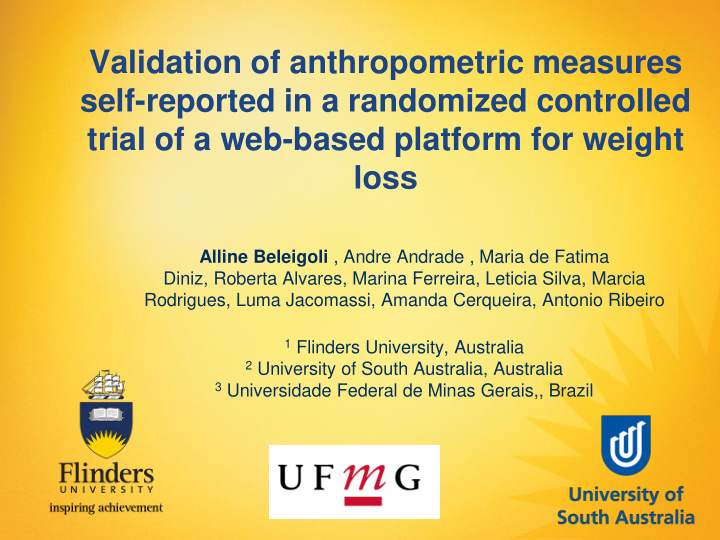



Validation of anthropometric measures self-reported in a randomized controlled trial of a web-based platform for weight loss Alline Beleigoli , Andre Andrade , Maria de Fatima Diniz, Roberta Alvares, Marina Ferreira, Leticia Silva, Marcia Rodrigues, Luma Jacomassi, Amanda Cerqueira, Antonio Ribeiro 1 Flinders University, Australia 2 University of South Australia, Australia 3 Universidade Federal de Minas Gerais,, Brazil
Funding National Institute of Science and Technology for Health Technology Assessment (IATS) – CNPq/Brazil. Prêmio CAPES de Teses FAPEMIG (PPM-00428-17)
Competing interests Andre Andrade is the owner of the company that provided the online platform that was adapted for this project
Obesity: a massive public health problem Men Women BMI >=30 kg/m2 Vigitel IBGE, Brazilian Ministry of Health, 2016 Source: AIHW
Obesity: a massive public health problem Accessibility and equity in obesity healthcare Web-based approaches are convenient to deliver weight loss interventions.
Question In adults with overweight/obesity, is a behaviour change program delivered by a web-based platform more effective than a minimal intervention for weight loss? Beleigoli et al. BMC Public Health. 2018 Aug 1;18(1):945
The POEmaS trial Beleigoli et al. BMC Public Health. 2018 Aug 1;18(1):945
The POEmaS trial 24-week intervention Primary outcomes: Weight and BMI change Self-reported, online
The POEmas Trial Convenience of electronic recruitment and online data collection in a difficult to engage population Accuracy of self-reported data
Validation study ❖ How accurate are the online weight and height reports? ❖ How biased reports impact on BMI? ❖ Participant’s characteristics associated with increased risk of misreporting?
Validation study Sample Random selection of 12.5% of the study population Balanced randomisation across study groups
Validation study Procedures • Participants were invited to a ‘clinical assessment’ by email • Unaware of reported vs measured anthropometry comparisons • Instructed to report weight and height on on the web platform on the day of the clinical assessment • Standardised methods of weight and height measures
Validation study Statistical analysis • Bland – Altman method • Ordinal logistic regression: Response variable: good agreement -0.5 to 0.5kg difference (reference), <-0.5kg and >0.5kg difference. Adjustment for age, gender, education, BMI, and study group
Results Characteristic POEmaS trial Validation study (n=1298) (n=159) Gender Female 996 (76.6) 128 (80.5) Age, years 33.6 (10.7) 36.5 (11.0) BMI, kg/m2 29.9 (4.3) 29.4 (4.1) Education Undergraduate 99 (18.2) 39 (24.5) Higher degree 445 (81.8) 120 (75.2) Group Minimal 470 (36.2) 59 (37.0) intervention Platform 420 (32.4) 42 (26.4) Platform plus 408 (31.4) 58 (36.6) online dietitian
Results Difference Reported online - measured BMI*** Weight (kg)* Height (cm)** (kg/m2) 0.4 0.4 0.03 Mean (SD) (1.7) (1.0) (0.9) *p=0.13; **p<0.001;*** p=0.06
Results
Results
Results
Discussion Smaller magnitude of differences in comparison to previous paper-based self-reported studies: • Effect of the feeling of anonymity associated with the online report? • Volunteer bias? Nicholau CK et al. European Journal of Public Health, 2017; 27: 898 – 903
Discussion Age, gender, education, BMI, and study group did not affect the accuracy of self-reported anthropometry Generalisability of the results Bonn SE et al. JMIR, 2013 Apr; 15(4): e52 Pursey K et al. JMIR 2014;16:e4 Nicholau CK et al. European Journal of Public Health, 2017; 27: 898 – 903
Conclusion Good agreement between online self-reported and measured anthropometric data Weight and height discrepancies are small and unlikely to be clinically important Online data collection is valid
Thank you alline.beleigoli@flinders.edu.au
Recommend
More recommend